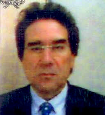Day 3 :
Keynote Forum
Salvatore Polizzi
Medicina Occupazionale e Ambientale, Italy
Keynote: Neurotoxic Effects of Aluminium and Alzheimer’s Disease: Single Photon Emission Computed Tomography (SPECT) imaging among retired foundry workers with mild cognitive impairment (MCI)

Biography:
Salvatore Polizzi has completed his School of Medicine in 1981, at the age of 24 years, from Turin University School of Medicine. He completed his Occupational Medicine residency program from Turin University School of Medicine in 1988. He is the director Occupational and Environmental Medicine since 1984 and of Oncological Screening Program since 2000. He has published more than 60 papers in reputed journals both national and international.
Abstract:
Introduction: Aluminium is a well known neurotoxic metal and in a previous study (Neurotoxicology 2002; 23:761-774) we found a probable relationship between inhalation of aluminium dusts and MCI. The present study examined SPECT in a small subgroup that accepted to perform the test.
Methods :In a cross sectional study we enrolled 29 subjects: 20 professionally exposed to Aluminium, 9 control without any known occupational exposure to the toxic metal.
We determined SPECT imaging, serum levels of Aluminium (Al-s) and Iron, blood levels of Manganese and different neurocognitive tests: Mini Mental State Examination score (MMSE-score), the time to execute the test (MMSE-Time), Clock Drawing test (CDT) and auditory event related evoked potential ERP-P300 (P300).
Results - Al-s levels in the controls were lower than 10 µg/L. (8,6 ± 1,5 µg/L) and none showed SPECT hypoperfusion.
In foundry workers, Al-s levels were significantly higher (p < 0,02) (12,9 ± 1,5 µg/L) and SPECT imaging was normal in two subjects (10%), while 18 (90%) showed some degree of cerebral hypoperfusion: 14 (70%) revealed hypoperfusion in the temporo mesial hippocampus, para hippocampal region, and frontal cortex and 4 (20%) showed hypoperfusion in the cerebral cortex.
Conclusions: Even if the small size of the studied population imposes prudence in the interpretation of the results, SPECT hypoperfusion seems to be compatible with aluminium exposure; this could be controlled implementing lifestyle/diet (physical activity, curcuma, silica enriched water) to slow the brain ageing, to reduce body burden and to chelate the metal.
Keynote Forum
David Rowell
Queensland Brain Institute, Australia
Keynote: An economic evaluation of deep brain stimulation for patients with Tourette’s syndrome: An initial exploration

Biography:
David Rowell is Post-doctoral Research Fellow in Asia-Pacific Centre for Neuro-modulation at Queensland Brain Institute. He has published more than 20 papers in reputed journals.
Abstract:
Background: Tourette’s syndrome (TS) is a neuropsychiatric movement disorder. Symptoms of severe TS include involuntary tics, vocalizations and coprolalia, which can progress to affect adversely health related quality of life. Co-morbidities include attention-deficit/hyperactivity disorder (ADHD), obsessive-compulsive disorder (OCD) and affective disorders. Typically, treatment may involve pharmacotherapy and supportive counseling. For a small number of patients, deep brain stimulation (DBS) is now being used to treat intractable TS. The clinical outcomes have generally been positive. To date, no economic evaluation of treating TS with DBS has been published. A well-designed economic evaluation has become a pivotal ingredient to ensure that the necessary resources are directed towards the healthcare services, which offer the best patient outcomes. The aim of this research is to present an initial exploration of an economic evaluation of DBS to treat severe TS.
Methods: We conduct a cost utility analysis (CUA), which compares the direct medical costs reported as $US and outcomes reported as quality-adjusted life years (QALYs) of DBS with best medical treatment (BMT). Our sample consists of 17 patients who received DBS for severe TS at St Andrews War Memorial Hospital, Brisbane, Australia from September 2008 to February 2012. Clinical indices for (i) tic severity (Yale Global Tic Severity Score) and (ii) depression (Hamilton Depression rating Scale) and (iii) age were collected pre and post DBS. These clinical data were converted QALYs using standardized coefficients derived from a multivariate regression published by Müller-Vahl et al (2010) for a sample 200 German outpatients (R 2 = 54%). The direct costs for DBS included hardware, surgical implantation, inpatient stay, neuro-stimulator programming and adverse events. For BMT direct costs included estimates for rehabilitation, inpatient stay, outpatient treatment, pharmaceuticals and ancillary treatments. All costs were reported in $US2016. TreeAge® software was used to estimate an Incremental Cost Effectiveness Ratio (ICER) using a Markov model, with a 10-year time horizon and 3.5% discount rate.
Results: The direct costs of DBS and BMT were estimated to be $USD 124,400 and $USD 34,180, respectively. DBS was estimated to increase health utility. The ICER was estimated to be lower than the $USD 50,000 per QALY threshold used by the Federal Drug Administration (FDA).
Conclusions: Our initial exploration suggests DBS is a cost-effective treatment for patients with severe TS. However, our economic evaluation contains several limitations. Firstly, indirect costs were not included. Secondly, health utilities pre and post DBS were imputed from clinical data rather than measured directly. Thirdly, long-term costs and benefits are uncertain; an average age of 28 years at implant implies a further 50 years of life post DBS. The ICER was sensitive to estimates of adverse events. Finally, our results were derived from a small sample. Future research will administer a survey of healthcare costs and QALYs to an international database of TS patients treated with DBS maintained by the University of Florida, with the aim of developing a more robust economic evaluation.
